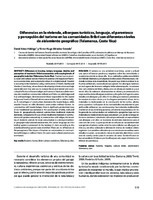Diferencias en la vivienda, albergues turísticos, lenguaje, el parentesco y percepción del turismo en las comunidades Bribri con diferentes niveles de aislamiento geográfico (Talamanca, Costa Rica)

Fecha
2015Autor
Arias-Hidalgo, David
Méndez-Estrada, Víctor Hugo
Metadatos
Mostrar el registro completo del ítemResumen
Tourism is an economic,
social and cultural activity that exerts positive and negative influences
on communities and ecosystems where it is implemented. Tourism
is occurring in the Talamanca valley communities of Yorkín, Bambú and
Shiroles (Costa Rica), where there is developing infrastructure and high
tourist demand. Our aim was to analyze the environmental and sociocultural
influence of tourist lodges and homes in Talamanca Bribri territory.
We visited ten communities in Bratsi and Telire, six with lodges and
four without lodges. We interviewed those responsible for the tourist
lodges and heads of households in communities with or without lodges.
A conical type of construction dominates the tourist lodges, while
wooden houses on stilts dominate communities without tourism. In
communities with tourist lodges, there is significant, predominant use
of non-traditional raw materials in the construction of stilts, walls and
floors. In geographically-isolated communities traditional materials
dominate, compared to the use of non-traditional materials in communities
with greater connectivity. In communities with lodges, the breeding
of domestic animals for meat consumption is a stronger tradition.
In geographically-isolated communities, the native language and the
kinship system is preserved. In the territory 21 clans according to the
matrilineal kinship system were identified. There are no differences in
the perception of the impact of tourism on communities. In communities
with lodges or without them, the same socio-cultural practices are
mentioned.
Descripción
Artículo científico
Fuente
Cuadernos de Investigación UNEDCompartir
Métricas
Colecciones
- Artículos [9]

